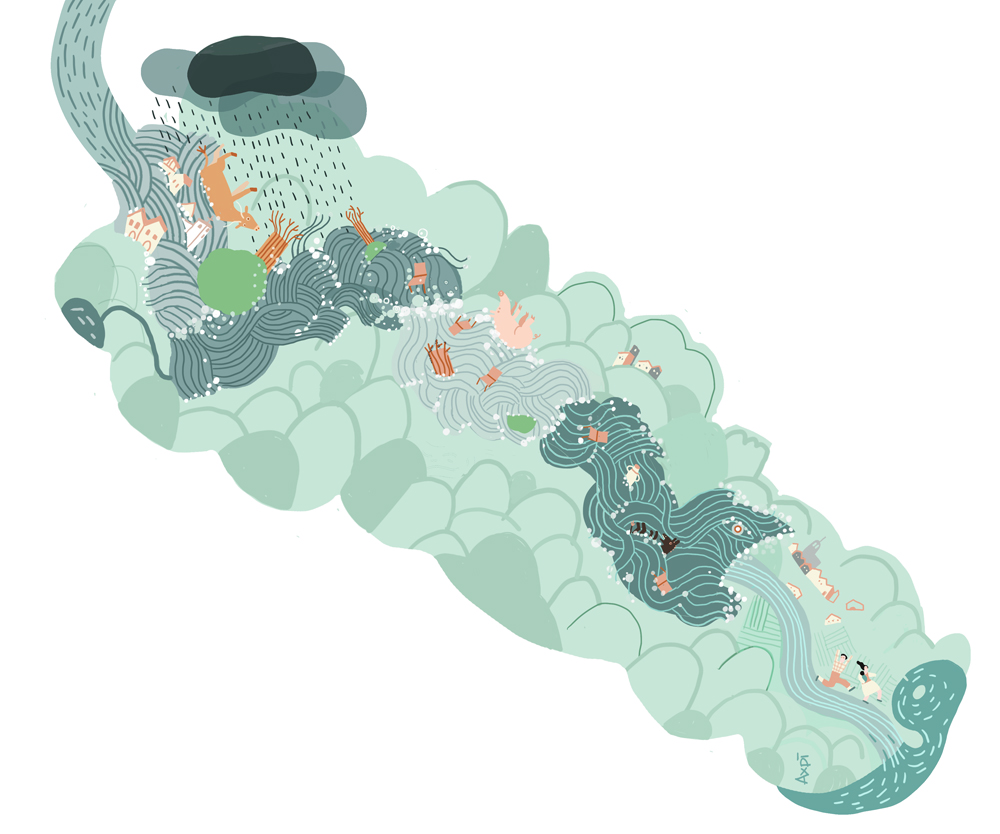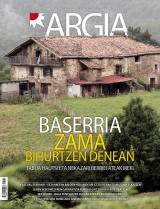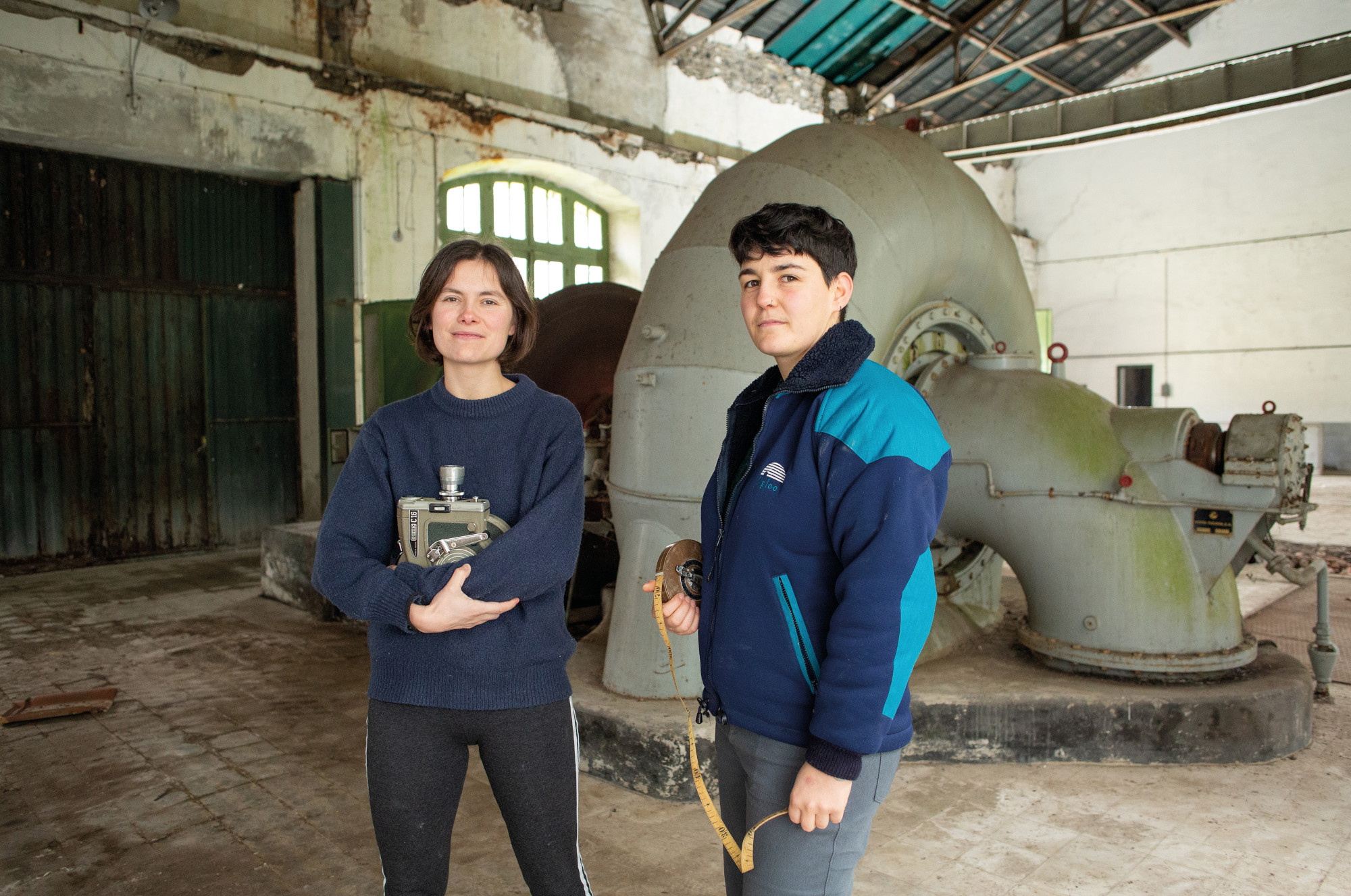When the fog explodes in the morning...
- Manuel felt the first blow of water when he was cleaning mites on the Ría. "But what's that, the wave? he thought. In his village, in Hernani, he did not throw a drop that morning, but in Goizueta “shot”. The Urumea climbed seven meters in almost an hour and it was Sunday morning when everyone was surprised by the surprise, including those who participated in the Mass. When the fog breaks out in the mornings... because even the priests have to walk carefully.

It was August 24, 1947, St. Bartholomew's day. Sunday after the Goizueta holidays. Mañoli Loiarte had the habit of going to the Mass of six and a half in the morning, and that day he also did. After listening to the Mass, she took the path of Alduntzin; she left Goizueta and headed to Hernani, as she worked as a maid of marquesitas in a palace on the banks of the downstream road.
Three Masses were held on Sundays in the morning and Antonio Elizalde, who was about to march at eight and a half, heard the first thunder. In the tranquility of the Mass, under the shelter of the church, few expected what they would find when leaving: “He who prevailed when we were at Mass – Antonio refers to the storm. Somewhere, above Goizueta, the fog exploded. It was throwing -- it wasn't raining. How do you remove the water from the container in the case? Like that!”
The plaza began to flood and the Great Bridge was going to be almost covered by the water. How was that possible? An hour before he could walk and the river… The woman named Rosa tried to cross the Great Bridge with the waters to the waist. It was the only way Miguel Strogoff could have escaped the stream, as he had to go to the farm. “People started fighting, not passing by or passing by. They finally took a cape and they passed it. The water ran with an extraordinary force and had already taken the bridge, the plaza and the church.
Water to the hip inside the church
Miracles Narbarte also did not forget that day. Her mother was very devout and, when she heard that the church had been knocked out, she rushed to help her. “In the church there were chairs for half women, half way, for men. The water would reach the hip and all the chairs would dance on the water. Pastor Don Juan was taken from the church with Miguel Sukuntza behind him.”
The plaza began to flood and the Great Bridge was going to be almost covered by the water. How was that possible? An hour before I could walk and the river…
In a short time the water was invading the village. The following day the document drafted by the City Council also stated: “The water reached seven meters high in Goizueta and the church and the plaza remained like a lake.” Miracles still remembers: “The waters coming out of the river formed waves in the plaza, like the dead waves of the sea, when they collided against the walls of the houses plat, plat...”
Mañoli was already in Alduntzin, about 2 kilometres from Goizueta. There, you didn't even notice the rain. I was concerned, however, that the Marquesitas did not return from the Mass at eight and a half. It didn't take much to realize that something extraordinary had happened. “From the palace window you saw the river, more and more water, more and more water... Below the river came the chairs and graves of the church! Then I realized that the water had invaded the church.”
The Urumea ran at full speed along the road to Hernani: trees, animals... dragged everything that weighed in front of him. Antonio remembers that at the time in Goizueta there was only one phone. “They called Hernani to be careful that the waters were flooded. However, the Hernaniarras will believe that there was the sun... then, of course.”
The River as the Wave
Manuel Garayar's father worked at the Lastaola plant in Hernani, 26 kilometers from Goizueta. And there, at work, they caught him when they called him from Goizueta. “Manuel, the mist has exploded in Goizueta and the water has grown,” said his father. Be careful in the farmhouse.” The dwarf Lizarra was on the bank and we had to be careful with the floods.
When the mother arrived from the Bretxa de San Sebastian, like every day, they went to clean milk mites that were empty from the market. The Urumea was low and there was no danger. However, as soon as he entered the Valley, young man Manuel perceived a small wave. When he raised his eyes, he saw what was going on. “Just like the wave, you started suddenly climbing the laughter. In one hour the water made all the barrels of the house dance and just didn't get to the block. It climbed about four meters around us.”
Many neighbors started trying to save the animals from the blocks. Hernaniarra Luis Elola also saw his properties in jeopardy, and to cross the Karabeleko Bridge to cross his house he was dragged by the water.
When the water strike reached the Karabel district of Hernani, three kilometers below, the chronicler of La Voz de España was on the train and saw “how the Urumea rose at the time”. The following day he wrote about what happened: “In a few minutes he began to leave his trail and covered all the grounds around the Urumea. I had to leave the Karabeleko Bridge where the river flooded both sides of the bridge.”
Many neighbors started trying to save the animals from the blocks. Hernaniarra Luis Elola also saw his properties in jeopardy, and to cross the Karabeleko Bridge to cross his house he was dragged by the water. There were those who risked her life to help her, but Luis disappeared.
As soon as he got up, the rung of the river came down again. Although the waters returned to their course, the remains of the flood continued for many days in the Urumea Valley, and for years lived that day in the memory of the neighbours.
Next day: trout at the riverbank wells
The day after the flood, the mayor of Goizueta wrote a statement to the Civil Governor of Navarra: “Many animals have died drowned, many crops destroyed, three dirty city plants, houses filled with water and the church turned into a lake. At the moment, the people are without water, without electricity and without a telephone. The road to Leitza and that of Hernani are closed, the town has been completely isolated: The losses amount to 4 million pesetas. The public is trying to re-launch all the services, as well as the cleaning of the plants.”
José Antonio Apezechea was also responsible for cleaning the plants. “That flood was bad for some, but good for us. Then there were a lot of people out of work and the day labors were very low.” Remember that between Goizueta and Leitza the road broke in seven points. “If the month’s salary was 16 pesetas plus the salary, after the flood five hardships started to be paid a day; those who had never seen the stone were the quarries.” Those of Goizueta and Leitza worked in the repair work and also those of Aranaz and Lesaka, “so he was a humpback for all”.
In Hernani, the next day was not a normal day either. All hops and crops planted on the banks of the Manuel Garay were lost. However, what caught our attention was a lot of wood that was against electric poles, “like a lot, we picked up wood for the whole year for the farmhouse.” But what you will never forget is the wells on the bank: “When the water came down, puddles remained at the lowest points, and at the trout wells. He walks by grabbing me by hand,” he tells us laughing.
In Karabel's neighborhood the morning was sadder. Luis Elola's body was drowned early in the morning on the shore of the Ebro Bank.
Lainoa lehertu zuen eremua oso mugatua izan zen. Lekukoen esanei kasu eginez, 5.000 Ha-ko zabalera izango zuen. Goizuetako herrian bertan elizaz behetik dagoen Olaberriko erreka ez zen mugitu ere egin. Ordea, elizaz goitik urrutiagotik datorren Zumarresta eta gertuago dagoen Urdiñola errekak esaterako, zeharo haziak zetozen.
Testigantzen arabera, Urdiñolan gertatutakoak azaltzen du zergatik joan zen ur-kolpea edo olatua Urumean behera. Jose Antonio Apezecheak ere hala kontatzen du: “Euria ikaragarri bota zuen eta erortzak edo ur-jauziak izan ziren. Urdiñola erreka txikiaren ertzean gaztainaren enborrak ziren moztuta eta paratuta. Erortzak enborrak goitik behetik hartuta, Leitzako mugan den zubi txikira eraman zituen eta zubi hura trabatu gaztainondoekin. Atzetik etorritako adarrek, lurrak eta orbelak uraren pasadizoa itxi zuten. Orduan bazter guztiak, denak, urak hartu zituen”.
Euskal Herriko beste lekuetan ere bizi izan dituzte antzeko fenomenoak. 1913an, esaterako, Baztanen, Bidasoa ibaian 12 metro zabal eta 5 luzeko olatua sortu zen; bertako herri eta inguruetan hemezortzi zubi birrindu eta bi emakume hil zituen. 1915ean berriz, Legazpin, Aizkorrin lainoa lehertu, eta urak kalte handiak sortu zituen herrian eta inguruetan.
Fenomeno meteorologiko asko errepikakorrak izan ohi dira. Ganix Esnaola Aldanondo EHUko ikertzailea eta irakaslea den atmosferaren fisikariak bere iritzia eman digu gertatu zena kontatzeko, eta berriro ere gertatu ote daitekeen argitzeko:
“Uholdea, azken finean, fenomeno meteorologiko baten emaitza baino ez da. Kasu honetan seguraski aurreko egunetatik zetorren ezengorkotasun egoera batetik garatutako ekaitz konbektibo bat izan zela dirudi, oso lokalizatua eta litro asko askatu zituena Goizueta inguruan, oso denbora gutxian. Posible al den errepikatzea? Meteorologian halako fenomenoekin probabilitateaz hitz egiten dugu, eta bai, dudarik gabe aukera badago berriro ere halako edo antzeko episodio meteorologiko bat gertatzeko. Galdera, ordea, ez da gertatuko den ala ez, baizik eta zein maiztasunekin gerta daitekeen. Hori erantzuteko nahikoa daturik ez dugu oraindik. Hala ere, gertatuta ere inork ezin du ziurtatu ibaiak erantzun bera izango duenik. Garai hartako Urumearen ezaugarriak eta egungoak ez baitira berdinak.”
With the Zabalduz caravan in the city of Bihac in Bosnia Herzegovina, activist Nihad Suljic explained to us that the Drina River is the largest tomb in the Balkans. In order not to be forgotten, he is responsible for identifying the bodies that are found and for giving them... [+]






















